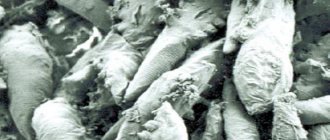Release form and storage conditions
The drug is produced in the form of a greenish-brown suspension with a specific smell of raw liver. The medicine is packaged in polymer bottles of 25 or 35 ml. The bottles are placed in a cardboard box along with a syringe-dispenser and instructions for use. The box indicates the composition, expiration date and storage conditions of the drug.
Unopened packaging can be stored for 2 years from the date of production. The shelf life of an open bottle is no more than 21 days.
Store Gepatovet at a temperature of +2 to +25 degrees Celsius, in a dry, dark place. It is advisable to store it in original packaging away from feed and food products. It makes sense to write the date of opening on the newly opened package to prevent the medicine from being used after the expiration date.
It is allowed to store the medicine in the refrigerator, but away from the freezer.
Important! Freezing the suspension leads to a complete loss of beneficial properties.
After the expiration date, the drug is disposed of. It is not advisable to use the bottle for household purposes.
The price of Hepatovet suspension ranges from 250 to 300 rubles. You can purchase it at specialized veterinary pharmacies.
Composition of Hepatovet
The drug contains the following components:
- Lecithin – serves to normalize the function of the cat’s liver, takes part in the construction of cells.
- Immortelle - has antibacterial and antispasmodic properties, reduces the viscosity of bile and helps in its excretion.
- Methionine – participates in the synthesis of creatine, neutralizes oxidation, and prevents fatty degeneration of the liver.
- Ornithine – normalizes the acid-base balance, has a stimulating effect on insulin production.
- Milk thistle – relieves inflammation, removes toxins, has antiseptic properties.
- Essential phospholipids - take an active part in restoring fat metabolism, improving metabolism. Activate the work of enzymes. Increases the body's ability to resist the effects of toxins.
Composition and action
All hepatoprotectors are, in the strict sense, not medicines, but dietary supplements. Even official medicine relatively recently began to use them in clinical therapy, especially in veterinary medicine. However, their effectiveness has been clinically confirmed, and now hepatoprotectors are successfully used to maintain liver function.
Common hepatoprotectors are preparations made from herbal components. The Hepatovet includes:
- milk thistle;
- immortelle grass and fruits;
- L-ornithine and methionine are two essential amino acids;
- essential phospholipids.
spotted milk thistle
– a medicinal plant known for hepatotropic properties. It contains silymarin. This is a mixture of alkaloids containing silybin, a substance with hepatoprotective, antioxidant and antitoxic effects. It is known that silymarin prevents the penetration of toxic substances into liver cells.
Sand immortelle
contains polysaccharides, vitamins, carotene, ascorbic acid, various salts and acids. Herbs and immortelle flowers increase the tone of the gallbladder, improve bile secretion, reduce the acidity of liver secretions, and have an anti-inflammatory effect.
L-ornithine
– an amino acid that, as a hepatoprotector, is involved in the regeneration of liver tissue and the process of neutralizing ammonia.
Methionine
activates proteins, reduces cholesterol levels and, conversely, increases the level of phospholipids. It prevents fat from accumulating in the liver and has a detoxifying effect.
Indications for use
Hepatovet is prescribed to cats in the following cases:
- for acute liver diseases;
- when treated with drugs that have a toxic effect on the liver;
- as an adjuvant in the treatment of helminthic infestations;
- in case of intoxication of the body;
- in case of poisoning.
The drug can be used to treat kittens, pregnant and lactating cats, but the prescribed dosage must be strictly followed.
Attention! Hepatovet is used only as prescribed by a veterinarian.
Are there effective drugs?
Are there hepatoprotectors with proven effectiveness? That is, such drugs, the positive effects of which have been proven as a result of research? Some groups of products have undergone clinical trials.
Their results:
- Phospholipids have demonstrated good performance in the treatment of hepatitis C in combination with interferons. At the same time, drugs of this group (Essenceale, Esliver, Phosphoglyph) have not shown good results in the treatment of alcoholic hepatitis and cirrhosis.
- Medicines containing ursodeoxycholic acid have a positive effect on bile stagnation, which is confirmed by several large studies. However, they do not have true restorative properties. The list of hepatoprotector drugs in this group includes Ursosan, Ursofalk.
- Preparations with thioctic acid - test results have not fully confirmed their effectiveness. This group includes Berlition, Octolipen.
- Herbal remedies – no large studies have been conducted and therefore their effectiveness has not been scientifically proven. Preparations – Karsil, Silimar.
- Medicines based on ademetionine - Heptral, Heptor, Heptor N. Showed good results in the treatment of the liver with its alcoholic lesions. However, with their use, there was no reduction in mortality and complications. Therefore, the test results were not considered reliable.
Thus, we can conclude that effective universal type hepatoprotectors that would completely protect the liver do not yet exist.
Be sure to consult your doctor about the advisability of using hepatoprotectors in your particular case.
Advantages and disadvantages of the drug
Advantages of the drug:
- Low cost relative to other hepatoprotectors.
- Convenient packaging with a measuring syringe.
- Natural composition.
- Treatment effectiveness.
Flaws:
- When using the medicine, cats may experience increased salivation.
- The odor of the suspension is unpleasant to humans.
- It has the following contraindications: liver failure, hepatic encephalopathy, epilepsy, individual intolerance to the components.
- There are rare side effects such as vomiting, nausea or allergies.
Instructions for use
Before using the medicine, you should try to calm the cat. Many pets, due to the specific smell of the suspension, do not mind trying it on their own. If you refuse to accept, the animal must be secured.
- Shake the bottle well before use. The suspension should be homogeneous, without sediment at the bottom.
- The medicine is given orally.
- The required amount of suspension is taken into a measuring syringe and poured into the cat’s cheek area, or onto the root of the tongue. You can mix the drug into wet food, but you need to make sure that the entire amount is consumed by the animal.
Dosage and duration of use
- For kittens and adult animals weighing up to 3 kg, a single dose is 1 ml. You can give no more than 3 ml per day.
- Animals from 3 to 6 kg receive 2 ml of the drug once. Per day – 6 ml.
- Cats over 6 kg are given 3 ml of suspension, about 7-9 ml per day.
The daily dose is divided into 2-3 doses per day, trying to maintain approximately the same period of time between doses.
The duration of treatment is determined by the veterinarian. Usually it lasts 1-2 months. The shortest duration of therapy is 3 weeks.
If necessary, courses are repeated after 15-20 days. Whether the pet will need to re-use Hepatovet or not should be determined by the veterinarian. Perhaps he will replace this medicine with another.
Video on how to give a cat a slurry:
How to use the medicine correctly
Shake the suspension thoroughly before use. Then, use a syringe to count out the required amount of medication and mix it with the food. There should be 0.1 ml of suspension per 1 kg of body weight. If the cat refuses food for some reason, the drug must be given forcibly using a syringe. To do this, the pet should be fixed, the jaws should be unclenched with your fingers and the medicine should be injected. The suspension should be given 2 times a day.
The suspension can be given to a cat forcibly
Treatment with tablets is carried out according to the same scheme. Before use, the drug must be crushed and mixed with a small amount of boiled water. Then add it to the food or force it using a disposable syringe without a needle, after first securing the cat and opening its jaws. The first method is easier. 1 tablet is designed for 10 kg of weight, so this form of release is intended for large animals.
You can give the pill to your cat using a disposable syringe without a needle.
The course of treatment with the drug is from 20 to 30 days. However, repeated therapy is possible on the recommendation of a doctor. The medication combines well with other medications, but for better results it is recommended to wait 1 hour and give another drug.
Attention! It is prohibited to increase the dose of medication without the consent of your doctor. This can provoke unwanted reactions.
A friend has a cat who was diagnosed with inflammation of the pancreas. The doctor recommended taking hepatoprotectors together with enzyme medications. During the therapy, the animal had slight itching, but the effect of the therapy was pleasing. At the end of treatment, the pet’s condition returned to normal and digestion improved.
Side effects
Hepatovet is a low-risk drug, so the list of side effects is small.
- Rarely, it may cause nausea and vomiting. In this case, it is necessary to consult a veterinarian who will help adjust the dosage of the drug or prescribe antiemetic medications for better absorption of the medication.
- An allergic reaction as a side effect can occur extremely rarely. If it occurs, the veterinarian will select another drug and prescribe antihistamines.
- Sometimes after ingestion, the animal may experience increased salivation. This situation does not require intervention from the owner. Usually this phenomenon goes away after 15-20 minutes.
Contraindications and side effects
Despite the fact that the main purpose of Hepatovet is the prevention and treatment of liver diseases, it is prohibited to give the essence to dogs with very severe liver failure. With progressive hepatic encephalopathy, a significant deterioration in the animal’s condition is also noted. The essence is also contraindicated for dogs suffering from epilepsy. Reviews from veterinarians about Hepatovet for dogs indicate that among the side effects, only intensified salivation is noted (the problem disappears by itself 15-20 minutes after taking the drops). In rare cases, allergies or individual intolerance to individual components of the drug develop.
Gepatovet's analogs
There are no analogues of Gepatovet on the Russian market, but there are hepatoprotectors with a similar effect. Imported medicines are more expensive.
| A drug | Difference from "Hepatovet" |
| Hepatoject | Available in the form of a solution for injection. Differs in higher cost. The injections are painful. |
| Heptral | The drug is produced in Germany in the form of tablets and solution for injections. Used for liver failure. |
| Covertal | It is a liquid for injection, which contains: extract of celandine, dandelion, colocynth, milk thistle extract. Produced in Russia. |
| Hepatolux | It can be in the form of a suspension or tablets. The composition includes phospholipids, glycine, L-arginine, extracts of medicinal herbs and royal jelly. |
| Hepatiale forte | Polish medicine in tablet form. It contains phospholipids, oleic acid, linolenic acid |
| Karsil | Tablets based on milk thistle extract. The drug is produced in Bulgaria. |
| Legafiton 50 | Tablets containing extracts of milk thistle and orthosiphon, L-ornithine. A medicine with a diuretic effect. Produced in France. |
Interesting! Some veterinarians classify Hepatovet not as a medicine, but as a biological food supplement.
"Hepatovet" has established itself as an effective and relatively safe remedy in the treatment of animal liver. However, you should not use the medication yourself. Any treatment for a cat must be agreed with a veterinarian.
Hepatovet for dogs
The drug Hepatovet is hepatotropic and is used for the prevention, treatment and restoration of liver cells. In fact, animal livers have an extraordinary ability to repair themselves, but only if given adequate support. In agreement with the veterinarian, Hepatovet can be used as a feed additive during treatment of the animal with other aggressive medications.
The liver is a unique organ that performs quite complex biochemical functions, including the breakdown of nutrients isolated from food into coenzymes suitable for absorption by the body. It also produces essential amino acids, enzymes, platelets, vitamins, proteins and cholesterol. But the most important function of the gland is detoxification. It is the liver that takes the brunt of the impact when toxins of organic or inorganic origin enter the dog’s body.
Hepatovet is a suspension that helps not only to regenerate damaged liver cells, but also to cure congenital and acquired disorders, as well as speed up the recovery of the dog’s body after endo- and exotoxicosis.
The instructions for Hepatovet for dogs say that the suspension can be used if the dog has the following symptoms:
- change in the color of the whites of the eyes (yellowing);
- discolored, oily stool;
- vomit;
- belching of bile;
- loss of appetite;
- bloating (not just in puppies).
For prevention, the suspension can be given to absolutely all dogs that are regularly treated with insecticides (for fleas and ticks), as well as pesticides (for internal parasites). Also, the liver is very negatively affected by preservatives, dyes and synthetic additives contained in low-quality feed.
In consultation with your veterinarian, Hepatovet can be given to dogs undergoing treatment with steroids or cortisone. Since the above medications directly affect the liver, the suspension will significantly reduce the degree of damage.











